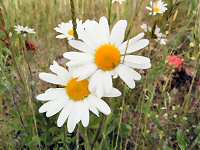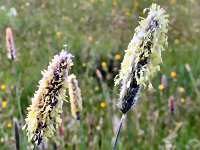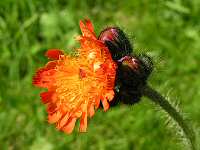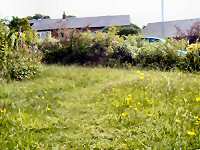Features: Wildlife Trust Articles |  |
Garden meadows Oxeye daisy. Most people would love to see this flower in their meadow.
What I'm about to describe will be music to your ears: a gardening project that actually involves you in less work instead of more! I want to tell you how to experience something of a wildflower meadow in your own garden by using the ingredients that are already there. Oxeye daisy. Most people would love to see this flower in their meadow.
What I'm about to describe will be music to your ears: a gardening project that actually involves you in less work instead of more! I want to tell you how to experience something of a wildflower meadow in your own garden by using the ingredients that are already there.
Creating a meadow the easy way Creating a full-blown perennial wildflower meadow is anything but a simple task Creating a full-blown perennial wildflower meadow is anything but a simple task Creating a full-blown perennial wildflower meadow is anything but a simple task; it can involve removing the existing vegetation (and sometimes even the topsoil), preparing a seed bed, re-sowing with suitable seed and then carefully nurturing the young sward for years. Even if you do everything 'by the book', the results can be unpredictable and will sometimes amount to no more than an expensive mistake. Creating a full-blown perennial wildflower meadow is anything but a simple task; it can involve removing the existing vegetation (and sometimes even the topsoil), preparing a seed bed, re-sowing with suitable seed and then carefully nurturing the young sward for years. Even if you do everything 'by the book', the results can be unpredictable and will sometimes amount to no more than an expensive mistake.
 Meadow foxtail in flower - a beautiful meadow grass.
But there is another way! In his influential book, How to make a Wildlife Garden, Meadow foxtail in flower - a beautiful meadow grass.
But there is another way! In his influential book, How to make a Wildlife Garden,  Chris Baines suggested staying the lawn mower from a selected part of your garden for a month or so from around the end of May Chris Baines suggested staying the lawn mower from a selected part of your garden for a month or so from around the end of May Chris Baines suggested staying the lawn mower from a selected part of your garden for a month or so from around the end of May. He called the effect of this a 'flowery hiccup' - a wonderfully evocative name for a gardening project which involves little more than putting your feet up. Chris Baines suggested staying the lawn mower from a selected part of your garden for a month or so from around the end of May. He called the effect of this a 'flowery hiccup' - a wonderfully evocative name for a gardening project which involves little more than putting your feet up.
The results of all your 'hard work' will depend largely on what is already there:  a delightful paradox is that you will get the best results from the worst areas of lawn! a delightful paradox is that you will get the best results from the worst areas of lawn! a delightful paradox is that you will get the best results from the worst areas of lawn! A neglected, weedy patch of grass that has had very little care lavished on it will probably be harbouring interesting and beautiful native plants just waiting to cut loose. a delightful paradox is that you will get the best results from the worst areas of lawn! A neglected, weedy patch of grass that has had very little care lavished on it will probably be harbouring interesting and beautiful native plants just waiting to cut loose.
 Fox and cubs: this relative of the dandelion flowers in my lawn when given the chance.
A key thing to understand about natural wildflower meadows is that they thrive on areas of low fertility. Fox and cubs: this relative of the dandelion flowers in my lawn when given the chance.
A key thing to understand about natural wildflower meadows is that they thrive on areas of low fertility.  The fine grasses and wildflowers that dominate natural meadows are adapted to do well on impoverished soils The fine grasses and wildflowers that dominate natural meadows are adapted to do well on impoverished soils The fine grasses and wildflowers that dominate natural meadows are adapted to do well on impoverished soils: on more fertile ground they are out-done by fast growing plants and coarse grasses. The fine grasses and wildflowers that dominate natural meadows are adapted to do well on impoverished soils: on more fertile ground they are out-done by fast growing plants and coarse grasses.
It doesn't have to be all sitting around with your feet up! For those who like to garden, a little judicious mowing in your meadow patch can be rewarding. Cutting a path through the meadow, or along one or more edges, can give it a 'cared for' look which very much suits the garden environment. It will also help you to persuade your neighbours that you haven't just given up!
A learning experience After a month or two, depending on how things go, you can cut the grass again After a month or two, depending on how things go, you can cut the grass again After a month or two, depending on how things go, you can cut the grass again. Over those four to eight summer weeks you will have had a well earned rest from mowing and experienced something of a wildflower meadow in your own back yard. I promise that you will: After a month or two, depending on how things go, you can cut the grass again. Over those four to eight summer weeks you will have had a well earned rest from mowing and experienced something of a wildflower meadow in your own back yard. I promise that you will:
- learn a lot about the nature of the soil and native flora of your garden and;
- be delighted by at least one unexpected plant!
 My own flowery hiccup in 2003. The mown path gives a 'cared for ' look.
I give you my personal 'money-back' guarantee. (But wait a minute; you won't have spent any money will you!) No one who is considering a more ambitious meadow project should do so before experimenting with a flowery hiccup for at least one year: the lessons learned could save time, money and heartache. My own flowery hiccup in 2003. The mown path gives a 'cared for ' look.
I give you my personal 'money-back' guarantee. (But wait a minute; you won't have spent any money will you!) No one who is considering a more ambitious meadow project should do so before experimenting with a flowery hiccup for at least one year: the lessons learned could save time, money and heartache.
I tried a flowery hiccup myself in 2003 (see The flowery hiccup) and I was delighted by the results. I did it on my front lawn (that's right - for all the world to see) by abstaining from mowing between mid May and the end of June. What most astonished me was that although uncut for around seven weeks, in places the grass grew no more than six inches! This may well have been influenced by the exceptionally dry summer, but I also think that the fact the lawn has never been pampered or fertilised contributed a great deal. As for the plants,  I was surprised most by the range of fine-leaved grasses that flowered and also by the meadow buttercups I was surprised most by the range of fine-leaved grasses that flowered and also by the meadow buttercups I was surprised most by the range of fine-leaved grasses that flowered and also by the meadow buttercups (much prettier than the creeping buttercups which rampage through my borders if left unchecked). I was surprised most by the range of fine-leaved grasses that flowered and also by the meadow buttercups (much prettier than the creeping buttercups which rampage through my borders if left unchecked).
I will certainly have more hiccups over the coming years. Eventually I may be more proactive in the creation of a meadow on this spot, but for now, I'm quite content to just watch and learn from nature.
| First published July 2004. | |
Copyright Richard Burkmar. Permission is hereby granted for anyone to use this article for non-commercial purposes which are of benefit to the natural environment as long the original author is credited. School pupils, students, teachers and educators are invited to use the article freely. Use for commercial purposes is prohibited unless permission is obtained from the copyright holder. |
Back to home page
Do you live in Merseyside? Interested in its wildlife? |